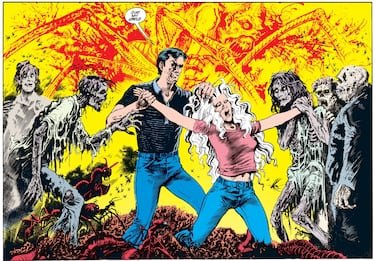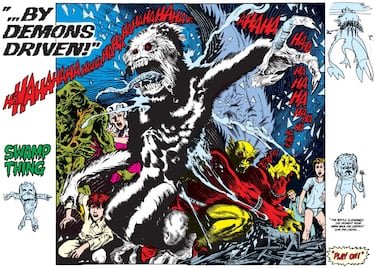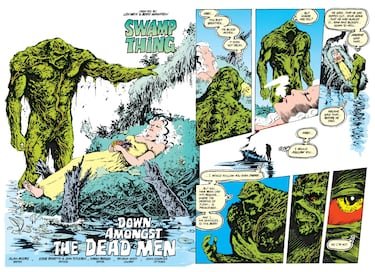(5 stars)
In the early 1970s, writer Len Wein—best known as the creator of Wolverine—and artist Bernie Wrightson introduced a haunting new figure to the DC Universe: Swamp Thing.
The creature made its debut in House of Secrets #92 (1971), a horror anthology that quickly became a cult favorite. The response was so strong that by 1972, Swamp Thing had earned its own ongoing series.
At first glance, Swamp Thing looked like a classic pulp monster—an eerie, moss-covered humanoid straight out of a Universal horror flick or a Gothic novel. But beneath the tangled vines and muck was Dr. Alec Holland, a scientist caught in a tragic explosion while developing a plant-based bio-restorative formula. What followed was a tale of vengeance, grief, and transformation, as Holland—now a creature of the swamp—sought justice for the murder of his wife and the destruction of his life’s work.

Meanwhile, in Europe: a genius emerges
While Swamp Thing was evolving stateside, a young British writer named Alan Moore was making waves across the Atlantic. In the pages of 2000 AD, Moore penned cerebral, genre-bending stories like Future Shocks, Skizz, and D.R. and Quinch. But it was his work on V for Vendetta and Marvelman (later Miracleman) in the magazine Warrior that truly put him on the map.
In 1983, Len Wein—then an editor at DC—recognized Moore’s talent and offered him a choice between two titles: Justice League or Swamp Thing. Moore chose the latter, drawn by its narrative potential and the creative freedom he was promised. That decision would change the course of American comics.
Moore became the first British writer to make a major impact at a U.S. publisher without relocating to the States. His success opened the floodgates for what became known as the “British Invasion” of comics, ushering in talents like Grant Morrison, Neil Gaiman, Peter Milligan, Garth Ennis, and Warren Ellis. His arrival also laid the groundwork for DC’s future Vertigo imprint, helmed by editor Karen Berger.

Moore’s radical rebirth of Swamp Thing
Moore’s take on Swamp Thing was nothing short of revolutionary. In just two issues, he dismantled the character’s origin and rebuilt it from the roots up.
In “Loose Ends,” Moore tied up lingering plot threads. But it was “The Anatomy Lesson” that redefined everything. Moore revealed that Swamp Thing wasn’t Alec Holland transformed—but rather a plant-based entity that had absorbed Holland’s memories. The creature was no longer a man trapped in a monster’s body, but a sentient plant with a consciousness that spanned the entire natural world.
This shift introduced deep philosophical, ecological, and existential themes, moving far beyond the original Frankenstein-in-the-muck concept. Moore’s Swamp Thing became a vessel for exploring the human condition, the environment, and the metaphysical.

Science, spirituality, and the roots of identity
To ground his reimagining in plausible science, Moore drew inspiration from the controversial “chemical memory” theory of 1950s biopsychologist James V. McConnell. According to McConnell, planarian worms could retain memories even after being bisected—and other worms that consumed them might inherit those memories. It was speculative science, but it gave Moore a compelling framework for Swamp Thing’s transformation.
Spiritually, Moore infused the series with the pantheistic philosophy of William Blake, whose influence also echoes through Watchmen. He layered in cosmic horror à la H.P. Lovecraft and borrowed the introspective tone of Beat poets to shape Swamp Thing’s inner monologues.
What began as a horror comic became something far more ambitious—a literary work that blended science, mysticism, philosophy, and environmentalism. Moore’s Swamp Thing spoke to a more mature, intellectually curious audience. The result? A critical and commercial triumph that elevated the medium itself.

Breaking the mold: Moore’s formal innovations
The first collected volume from Panini includes issues #20 through #34 of the original series, where Moore introduced sweeping changes. He brought in mystical and supernatural characters from DC’s deeper lore—like Etrigan the Demon, Deadman, and The Phantom Stranger—seamlessly integrating Swamp Thing into the broader DC Universe.
Moore also shattered the linear storytelling typical of superhero comics. He used time jumps, multiple narrators, and fragmented perspectives to build layered, emotionally resonant narratives. In issue #25, “The Sleep of Reason,” five characters recount their experiences simultaneously, creating a kaleidoscopic view of fear and trauma.
The horror in Moore’s run wasn’t just physical or supernatural—it was deeply psychological. He explored childhood fears, madness, death, and the unknown through symbolic and often mystical lenses. Themes like the afterlife, the souls of non-human beings, and communion with otherworldly entities became central.
His prose blended lyrical beauty with philosophical depth. Swamp Thing’s voice became introspective and spiritual, deeply attuned to the natural world. Ecology wasn’t just a theme—it was the narrative’s backbone. The creature merged with the landscape, felt the pulse of the plant kingdom, and acted as its guardian. This ecological consciousness gave moral weight to actions that might otherwise seem monstrous.

A comic that changed everything
Swamp Thing isn’t just a comic—it’s a genre-defining masterpiece. It’s the monolith from 2001: A Space Odyssey, planted in the heart of the DC Universe. Alan Moore didn’t just write stories; he planted the seeds for the most creatively fertile era in comic book history.
Thanks to Moore, comics shed their reputation as mere children’s fare and emerged as a powerful cultural force. His prose stands shoulder to shoulder with literary giants like James Joyce, Thomas Pynchon, and Cormac McCarthy—using language as a gateway to the spiritual and the sublime.

Related stories
Get your game on! Whether you’re into NFL touchdowns, NBA buzzer-beaters, world-class soccer goals, or MLB home runs, our app has it all.
Dive into live coverage, expert insights, breaking news, exclusive videos, and more – plus, stay updated on the latest in current affairs and entertainment. Download now for all-access coverage, right at your fingertips – anytime, anywhere.



